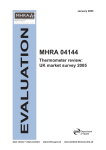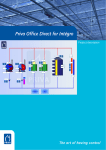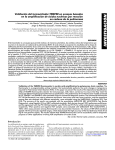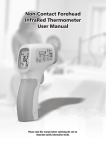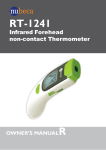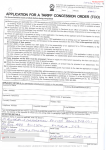Download User Manual - Brannan Thermometers and Gauges
Transcript
Non-Contact Infrared Forehead Thermometer 11/400/3 User Manual Please read this manual before switching the unit on Important safety information inside Non-Contact Infrared Forehead Thermometer Contents 1. General Description ..............................3 2. Safety Information ....................................3 3. Features..........................................4 4. Configuration ... ... ... ... ... ... ... ... ... ... ... ... 4 5. Digital Display Symbols ... ... ... ... ... ... ... ... ... 4 6. Description of Label Symbols ... ... ... ... ... ... ... ... ... 4 7. Technical Specifications ... ... ... ... ... ... ... ... ... 5 8. Typical Temperature Data..............................5 9. Calibration Check ... ... ... ... ... ... ... ... ... ... ... ... 6 10.Use .............................................6 11. Options and Settings ... ... ... ... ... ... ... ... ... ... ... 7 12. Maintenance and Cleaning... ... ... ... ... ... ... ... ... ... 8 13. Troubleshooting ... ... ... ... ... ... ... ... ... ... ... ... 8 14. Applicable Standards ... ... ... ... ... ... ... ... ... ... ... 9 15.EMC Statement .................................9 Non-Contact Infrared Forehead Thermometer - User Manual 1. General Description This Non-Contact Infrared Forehead Thermometer is specially designed to measure the body temperature of infants and adults (32 to 42.5°C / 86 to 108°F) in a range of ambient temperatures and conditions without contact to human body. It can also be used to measure the surface temperature of objects between 0 and 60°C (32 to 140°F) using the surface temperature function. 2. Safety Information • This device must only be used for the purposes described in this instruction manual • The operating ambient temperature for this device is 10 to 40°C. (50 to 104°F) • The maximum operating ambient humidity is 85%RH • Store the device between 0 and 50°C • Do not expose this thermometer to sources of electrical voltage or current • Do not use the device near sources of electromagnetic radiation • Do not expose the device to water or heat, including direct sunlight This thermometer is intended as a quick and simple way to check the core body temperature of a patient. It does not negate the need to consult a doctor or get medical help if symptoms persist. A number of factors can affect the readings obtained, these include: • Device has been dropped or knocked sufficient to alter the calibration • Hair and perspiration on the patients forehead • The wearing warm clothing prior to the reading being taken • Taking physical exercise shortly before a reading is taken • Drinking hot or cold fluids • Variations in skin type between patients • The time of the day • Distance of the sensor from the patient as the reading is being taken • The temperature of the thermometer if it is different from that of the room • Cleanliness of the sensor • Measuring mode in which the thermometer is used 4 Non-Contact Infrared Forehead Thermometer - User Manual 3.Features • • • • • • • Precise non-contact measurements of either Body or Surface temperatures. User selectable °C or °F Programmable alarm function at user defined value Memory facility remembers last 32 measurements Automatic data hold and auto power off Automatic range selection and fixed display resolution of 0.1°C (0.1°F) Backlight LCD display 3 1 4. Configuration 1. 2. 3. 4. 5. 6. 7. 8. Infrared Sensor LCD Display Mode Selection Switch Down Button Up Button Mode Button Measurement Trigger Battery Compartment Cover 2 6 5 4 7 8 5. Digital Display Symbols 1. 2. 3. 4. 5. 6. 7. 8. Surface Temperature Mode Symbol Body Temperature Mode Symbol Digital Temperature Readout Battery Level Memory Location Number Saved Data Value Temperature Units (°C / °F) Audible Tone Symbol 1 2 3 5 8 7 4 6 5 Non-Contact Infrared Forehead Thermometer - User Manual 6. Description of Label Symbols The device is in accordance with Medical Device Directive 93/42/EEC Body Surface The device is in accordance with FCC Part 15 Subpart B:2007/Radio Frequency Devices IC Regulation ICEC-003: 2004 Interference-causing Equipment Standard-Digital Apparatus 3V DC Power Supply Type B Equipment In order to protect the environment, please recycle the device according to the local regulations Indication of Mode Attention, consult accompanying documents. 7. Technical Specifications Normal Conditions of Use Display Resolution 0.1°C (0.1°F) Operating Temperature 10 to 40°C (50° to 104°F) Storage Temperature 0 to 50°C (32° to 122°F) Max Operating Humidity <85%RH Power 2 x AA batteries Size 149 x 77 x 43mm (L x W x H) Weight Gross 400g / Net 172g Measuring Range In Body Mode In Surface Temp Mode Accuracy Measuring Distance Automatic Stop 30.2 to 42.5°C (90° to 108°F) 0 to 60°C (32° to 140°F) +/-0.3°C (0.54°F) 5 to 15cm 7 seconds Non-Contact Infrared Body Thermometer Precision 32 to 35.9°C / 93.2 to 96.6°F +/-0.3°C / 0.5°F According to ASTM 36 to 39°C / 96.8 to 102.2°F +/-0.2°C / 0.4°F Standard E1965-1998 39 to 42.5°C / 102.2 to 108.5°F +/-0.3°C / 0.5°F (2003) 6 Non-Contact Infrared Forehead Thermometer - User Manual 8. Typical Temperature Data Normal Temperatures According to Measurement Method Measurement Method Normal Temp °C Normal Temp °F Rectal 36.6 to 38.0 97.8 to 100.4 Oral 35.5 to 37.5 95.9 to 99.5 Axillary 34.7 to 37.3 94.4 to 99.1 Ear 35.8 to 38.0 96.4 to 100.4 Normal Temperatures According to Age Age Temp °C 0 - 2 years 36.4 to 38.0 3 - 10 years 36.1 to 37.8 11 - 65 years 35.9 to 37.6 >65 years 35.8 to 37.5 Temp °F 97.5 to 100.4 97.0 to 100.0 96.6 to 99.7 96.4 to 99.5 9. Calibration Check This device uses an external temperature to determine the equivalent core temperature of the patient. Calibration is carried out in our factory as part of our manufacturing process, but variations between ethnic groups and patient demographics can lead to slight increases in uncertainty in the final reading. In order to verify the accuracy of readings, it is possible to carry out a calibration of the device by comparing it to a conventional clinical thermometer. If slight differences are seen between the readings of the two thermometers, an adjustment can be made to the device by applying a small offset to the displayed value. 1. Take a number of temperature readings of a person using a conventional clinical thermometer. (Take sufficient readings to be sure that you have a consistent value.) 2. Ensuring that you have considered all the factors which can affect the reading, take a number of temperature readings of the same patient using the IR Body Thermometer. 3. Compare the readings. If they are the same, then the thermometer can be used as it is. If there is a small difference between the readings, then an offset can be applied to the output of the IR device in order to negate the inaccuracies seen in use. • If an adjustment is required, press the ‘MODE’ button for 2 seconds until the screen displays F1. • Press the ‘MODE’ button again until the display shows F3. • Press the ‘UP’ or ‘DOWN’ button in order to add a positive or negative offset. 7 Non-Contact Infrared Forehead Thermometer - User Manual 4. 5. Carry out the comparison again (Steps 1 & 2) and compare the readings. If they are the same, then the thermometer can be used without further adjustment. If there is still a difference between the readings, then the offset can be adjusted again in order to obtain a more consistent reading. Repeat the procedure until you are happy that the two thermometers are giving the same results. 10.Use 1. 2. 3. 4. Install the batteries, taking care to ensure the correct polarity. When using for the first time or when new batteries are inserted, wait for 10 minutes for the instrument to warm up to room temperature. If the device is not used for an extended period there will be a short delay (1-2 secs) while the device measures the room temperature. Aim the sensor towards the forehead (see the diagram for correct positioning), at a distance of 5 to 15cm (2 to 5.9 inches). 5. Press the measurement trigger and the recorded temperature will be displayed immediately. Remember to consider the points in section 2 to improve the accuracy of your readings. 6. If difficulty is experienced in obtaining consistent readings, it is possible to measure the temperature behind the patients ear lobe. Similarly, make sure the area is not covered by hair, perspiration, cosmetics or clothing. Important:The forehead temperature differs from the internal body temperature. To obtain the correct core temperature always use in Body mode. 8 Non-Contact Infrared Forehead Thermometer - User Manual 11. Options and Settings 1. Choosing the Temperature Units – F1 Function • Press ‘MODE’ button for 2 seconds, the screen displays: F1. • Press ‘DOWN’ for degrees Celsius, ‘UP’ for degrees Fahrenheit. 2. • • Alarm Setup – F2 Menu Press ‘MODE’ for 2 seconds, the screen displays: F1. Press ‘MODE’ again to get F2. Select ‘UP’ to increase and ‘DOWN’ to decrease the threshold by 0.1°C (0.1°F). Note: The alarm threshold default value is 38°C (100.4°F). 3. • • • • Calibration Offset – F3 Menu To adjust the total variation of the non-contact Infrared Body Thermometer: Press “MODE” for 2 seconds, and then again until the screen displays: F3. Select “UP” to increase the offset by 0.1°C (0.1°F), “DOWN” to reduce it by 0.1°C (0.1°F). If the operating environment or the patient demographic changes significantly the calibration offset should be adjusted. Note: This function is only effective in Body mode. 4. • • Buzzer ON/OFF – F4(F3) Menu Press ‘MODE’ for 2 seconds, the screen displays: F1. Press ‘MODE’ repeatedly until the screen displays F4 (F3 in Surface Mode). Select ‘UP’ to activate the buzzer (a speaker icon “ “ is displayed on the LCD screen), Select ‘DOWN’ to deactivate (the icon will disappear). 5. Exiting the Settings Mode • Press “MODE” button until the screen turns off. 6. Data Memory • Data is automatically stored after each temperature measurement. This will display at the right corner of LCD. Press “UP” or “DOWN” button to display the last temperature measurement. • With the power off, press the “UP” and “DOWN” button together for two seconds, to display the last temperature measurement. • Press the ‘DOWN’ button to go to memory position 00 and then press the ‘MODE’ button to delete all memorised data. 9 Non-Contact Infrared Forehead Thermometer - User Manual 7. • • • • Changing the Batteries When the LCD screen displays “ “, the battery is ready for replacement. Open the battery lid by pushing it forward and change the batteries. Ensure the batteries are inserted the correct way. Inserting them with the wrong polarity could damage the device and invalidate the warranty. Never use rechargeable batteries. Remove the battery from the instrument if it is not required for extended periods in order to avoid damage to the thermometer resulting from a leaking battery. 8. Longevity of Use • This device has been designed for prolonged professional use, expected to exceed 40,000 individual readings. 12. Maintenance and Cleaning • It is important to look after the protective glass over the sensor of the thermometer. It can be cleaned with a cotton bud lightly moistened with alcohol. • Do not clean the device with corrosive detergents. • Keep the device away from water or other liquids. • Store the device in a dry environment, and keep it away from dust and direct sunlight. Should any other problems occur with your device, please contact your retailer. Do not attempt to repair the device yourself. 10 Non-Contact Infrared Forehead Thermometer - User Manual 13.Troubleshooting If you experience problems while using your Non-Contact Infrared Body Thermometer please refer to this troubleshooting guide to help resolve the issue. If the problem persists, please contact our customer service. The screen displays a body temperature of lower than 32°C (89.6°F). The device is switched to Surface mode and the 32°C (89.6F) displayed is not a true reading of the core temperature of the patient. The screen displays the message “HI” When using the thermometer the message HI can sometimes show on the screen. The temperature seen is above the measurement range selected, either greater than 42.5°C (108°F) in Body mode or greater than 60°C (140°F) in Surface mode. The screen displays the message “LO” When using the thermometer the message LO can sometimes show on the screen. The temperature seen is under the measuring range selected, either less than 32°C (90°F) in Body mode or less than 0°C (32°F) in surface mode. Other reasons for “LO” or “HI” Message Advice Temperature reading hampered by hair Make sure that there is no obstruction or perspiration, etc prior to or taking a reading Temperature altered by the flow of air Make sure there are no draughts which over the surface being measured could raise or lower the temperature Incorrect measuring distance used Position the sensor between 5 and 15cm from the patient The instrument is at a different Allow the instrument longer to reach the temperature to the room in which it is room temperature being used 11 14. Applicable Standards • • • • • EN 12470-5 and ASTM E1965-1998 EN 980: Graphical symbols for use in the labeling of medical devices EN 1041: Information supplied by the manufacturer with medical devices EN 60601-1: Medical electrical equipment Part 1: General requirements for safety (IEC: 60601-1:1998) EN 60601-1-2: Medical electrical equipment Part 1-2: General requirements for safety Collateral standard Electromagnetic compatibility Requirements and text (IEC 60601-1-2:2001). 15. EMC Statement This device has been tested and homologated in accordance with EN 60601-1-2:2007 for EMC. This does not guarantee in any way that the device will not be affected by electromagnetic interference. Avoid using the device in a strong electromagnetic environment. The MEDICAL ELECTRICAL EQUIPMENT needs special precautions regarding EMC and needs to be installed and put into service according to the EMC information provided in the ACCOMPANYING DOCUMENTS. The manufacturer reserves the right to alter the specifications of the product without prior notification. S Brannan & Sons Ltd Leconfield Industrial Estate Cleator Moor Cumbria UK CA25 5QE Tel: +44(0) 1946 816600 Fax: +44(0) 1946 816628 BRAN.2015.REV1












